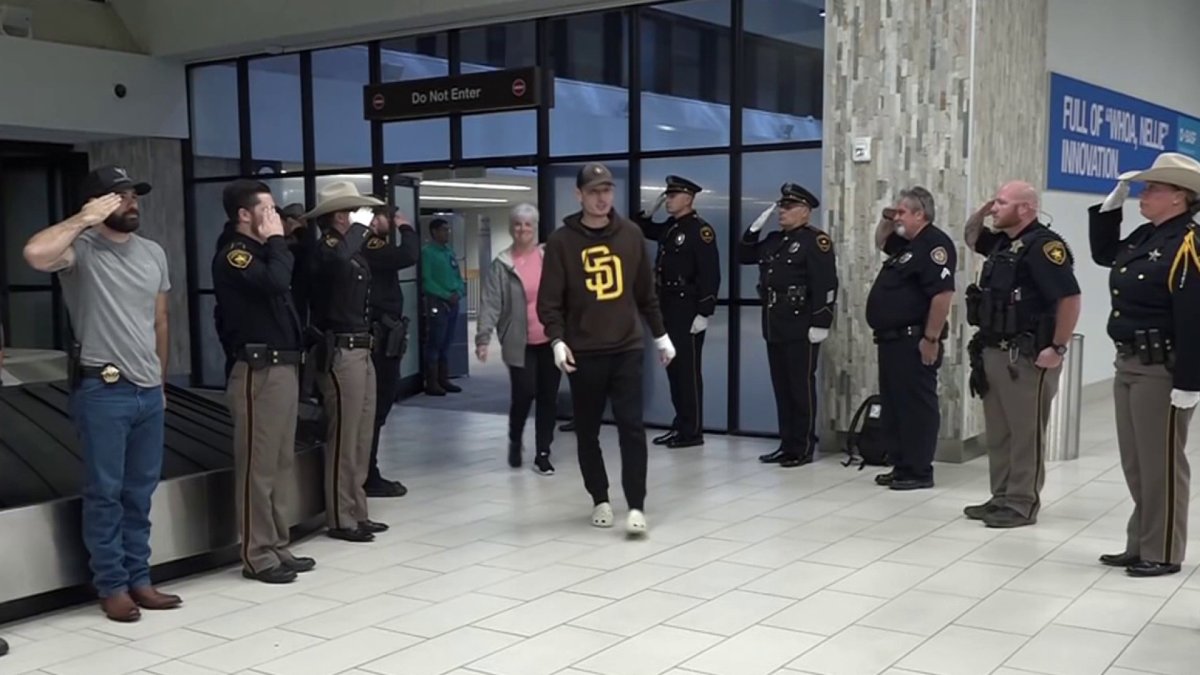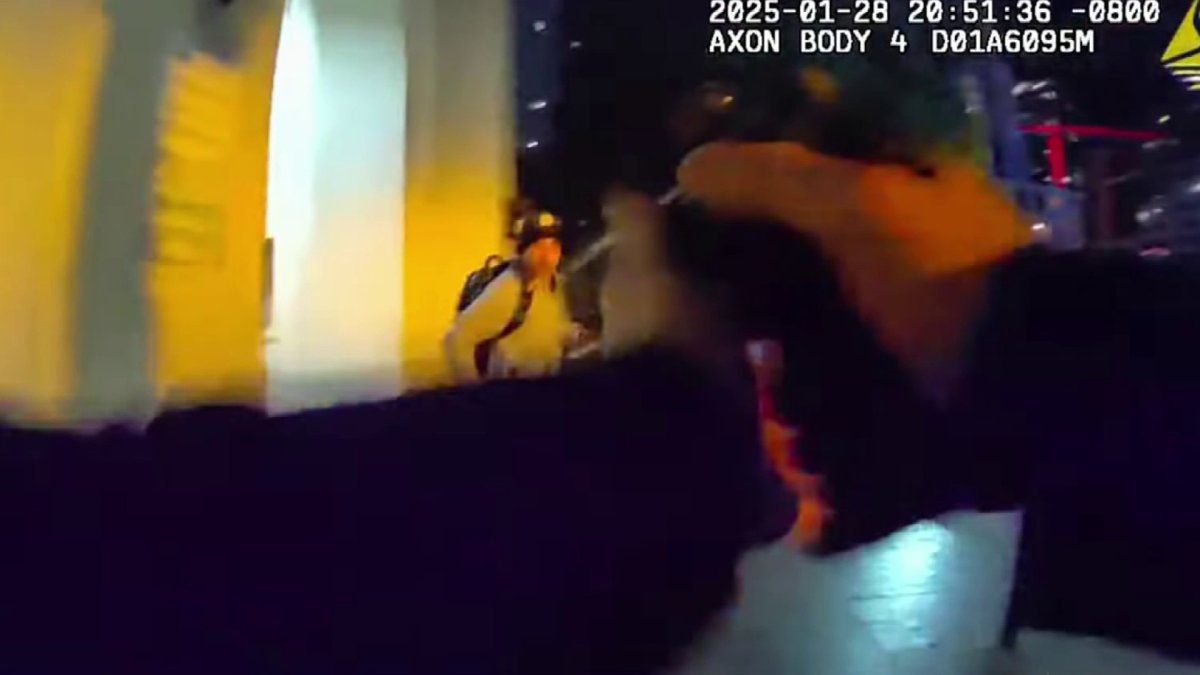San Diego, CA
San Diego police officer injured in Clairemont crash returns to Texas for recovery

A San Diego police officer seriously injured in a crash late last month that claimed the life of his partner has returned to his native Texas to complete his recovery.
Officer Zachary Martinez, who suffered serious burns and other injuries when a car that had been involved in a police pursuit slammed into the patrol car he was in, was released from the hospital earlier this month.
This past weekend, Martinez attended the funeral for his partner, 30-year-old Austin Machitar, and even walked up to the stage where Machitar was being honored for his service.
On Monday night, Martinez returned to his family’s hometown in Lubbock, Texas.
“I was shocked,” Martinez said on Monday night at the airport after his plane landed, his hands still encased in bandages and some bruising visible under his eyes. “I was not expecting this at all, especially when they boarded the plane and made me stand up and come walk to the front of the plane. I was not expecting — was expecting, OK, some family and friends, and things like that, but coming out and seeing a full lineup of everybody, it was great. It was awesome.”
The officers were killed in the crash on Aug. 26 when a teenage driver who was behind the wheel of the gray BMW slammed into the SUV in which the officers were riding.
Martinez’s father told NBC 7 in August that his son, who has been a sworn officer in San Diego for the past 18 months, is a hero who dedicated his life to serving.
“He was born and raised to serve,” San Diego Police Chief Scott Wahl said during a news conference the day after the crash. “He’s an EMT. His heart is into helping people.”
Zach Martinez’s road to the police force began in 2014. In high school, he joined the Lubbock Police Department Explorer Program in Texas. Officer Brinnen Kent, Zach Martinez’s former instructor, described Martinez as a smart competitor who helped the explorers win leadership and other awards.
Because Martinez couldn’t join the San Diego Police Department until he was 21, he joined the Navy’s military police at 18, according to Kent.
Kent said the week before the crash when they spoke, Martinez talked about how excited he was to be serving in San Diego.

San Diego, CA
San Diego relief teams assist Jamaica’s recovery post-Hurricane Melissa

SAN DIEGO (FOX 5/KUSI) – Hurricane Melissa, one of the strongest storms to ever hit Jamaica, has left widespread destruction across the Caribbean. San Diego-based International Relief Teams is already mobilizing food, shelter and rebuilding supplies.
The Caribbean is still recovering from Hurricane Melissa, one of the most powerful storms to ever hit Jamaica. Whole communities were destroyed, and officials warn recovery could take years.
San Diego-based International Relief Teams (IRT) is already on the front lines, helping families survive and rebuild.
Hurricane Melissa slammed into Jamaica as a Category 5 storm, with winds topping 180 mph, tearing through homes, farms and critical infrastructure. More than 50 people across the Caribbean have been reported dead, and hundreds of thousands remain without power.
Catastrophic Damage
Widespread flooding, destroyed homes, and debris-covered communities mark western Jamaica, where Melissa left catastrophic damage.
“It’s pretty bad. Whole communities have been devastated,” Rose Uranga, chief operating officer at IRT said.
Uranga said the nonprofit, active since 1988, responds to disasters worldwide and locally. But in Jamaica, the work is just beginning.
“Right now we are focusing on the critical needs, food, water, shelter, baby formula, diapers, blankets,” Uranga said. “We’re sourcing everything locally, which allowed us to respond quickly.”
Partnering with local labor not only speeds up recovery, she said, but also keeps money flowing into Jamaica’s economy.
“In the coming weeks and months, we will be filling containers and sending them over,” Uranga said.
IRT leaders say they will stay committed as long as it takes to help communities rebuild.
“This is going to be a long recovery effort. We will be providing as we go forward building materials, drywall, and paying local labor to rebuild. It will be quite a long process,” Uranga said.
IRT plans to begin filling and shipping containers to Jamaica in the coming weeks and will send volunteer teams once rebuilding begins.
The nonprofit has been providing disaster relief since 1988 and says it will remain in Jamaica as long as necessary to help families recover.
IRT is also preparing to assist in Los Angeles with wildfire recovery and continues to respond to humanitarian crises in Sudan.
IRT says they rely heavily on donations to assist those in need. To learn more visit their website.
San Diego, CA
Bryan Copeland – San Diego Union-Tribune

Bryan Copeland
OBITUARY
George Bryan Copeland was called home to Heaven on September 26, 2025.
George Bryan was born on August 18, 1947, in La Mesa, California, to John and Patricia Copeland.
While attending school, George Bryan was especially interested in playing baseball, and he was a big fan of the San Diego Padres. For several years, he was a member of the San Diego Zoo and enjoyed many hours visiting the animals.
After graduating from high school in 1966, George Bryan enlisted in the United States Marine Corps.
He was a supply clerk, rising to the rank of Corporal.
Following his military service, George Bryan embarked on a career as an electrician with the State of California Department of Corrections.
George Bryan resided in La Mesa at the time of his passing.
George Bryan is survived by his former wife Rosalie, sons Joshua and Scott, and brothers Bill and Paul. Bryan will be memorialized November 8th at the Piccadilly Village Clubhouse.
San Diego, CA
Love and scares: San Diego couples tie the knot at haunted chapel wedding

SAN DIEGO (FOX 5/KUSI) — This Halloween, the San Diego County Clerk’s office transformed into a haunted chapel of love for its second annual Halloweddings. Costumed officiants, creepy vows, and spooky decorations set the scene for couples ready to say “I do” in true Halloween style.
For Angela Tran and Phillip Ona, Halloween has always been special. On Friday afternoon, it wasn’t just about candy and costumes, it was their anniversary, and they decided to make it extra memorable.
“We wanted a silly way to get legally married,” Angela said. “Our anniversary is around Halloween, and we had so much fun putting this together.”
Dozens of couples took part in the Halloween-themed ceremony, hosted by the County Clerk’s Office, exchanging vows like:
“Dear friends, we have been summoned here today for the hauntingly joyful wedding of Angela to her boo Phillip.”
County Clerk and Commissioner of Marriages Jordan Marks says events like Halloweddings are about making love less stressful and more memorable:
“People want a great time to celebrate. What better day than Halloween? Now couples get to do that for their entire lives every Halloween.”
No appointments. No long waits. Just walk in, get your marriage license, and tie the knot.
“Halloween is filled with some of the greatest love stories of all time,” Marks added. “Today, people get to pledge their undying love and say ‘I doo’ to their boo.”
For some couples, the theme got extra creative.
“We’re vampires. I don’t know if you bit me, we both have blood,” laughed Angela.
Beneath the darkness, the only thing truly immortal was their love.
-

 Milwaukee, WI5 days ago
Milwaukee, WI5 days agoLongtime anchor Shannon Sims is leaving Milwaukee’s WTMJ-TV (Channel 4)
-

 News6 days ago
News6 days agoWith food stamps set to dry up Nov. 1, SNAP recipients say they fear what’s next
-

 Alabama1 week ago
Alabama1 week agoHow did former Alabama basketball star Mark Sears do in NBA debut with Milwaukee Bucks?
-

 News1 week ago
News1 week ago1 dead, 6 injured in shooting at Lincoln University homecoming festivities
-

 Austin, TX1 week ago
Austin, TX1 week agoDia De Los Muertos Austin: Parades, Altars & Events
-

 Politics1 week ago
Politics1 week agoTrump to jet off to Asia as North Korea fires ballistic missiles and China trade questions loom
-

 Seattle, WA5 days ago
Seattle, WA5 days agoFOX 13’s Aaron Levine wins back-to-back Jeopardy! episodes
-

 Culture4 days ago
Culture4 days agoVideo: Dissecting Three Stephen King Adaptations

















